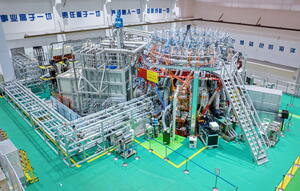Collaborative research intensifies on China's HL-3 tokamak
In the framework of a deepened collaboration between the Southwestern Institute of Physics (SWIP), China and the ITER Organization, the HL-3 tokamak has become a satellite device of ITER. A campaign dedicated to deuterium-tritium plasma experiments in support of ITER's physics research and operation is planned.
In December 2023, the ITER Organization signed an agreement for academic, scientific and technical cooperation with the Southwestern Institute of Physics (SWIP) in Chengdu, China. SWIP has built more than 20 experimental devices for controlled nuclear fusion research, including medium-sized tokamaks HL-1 (1984) and HL-1M (1994), divertor-based tokamak HL-2A (2002), and the advanced-divertor tokamak HL-3 (formerly called HL-2M) that achieved first plasma in 2020 and high-confinement operation (H-mode) in August 2023.
Collaboration is now intensifying in areas such as integrated operation scenarios simulation, disruption physics, and plasma control. The spring 2025 experimental campaign has attracted international research teams from the United States, France, Japan, South Korea, Portugal, and Thailand for joint investigations that will target key challenges for high-fusion-power-production deuterium-tritium (DT) plasmas in ITER such as high-beta plasma sustainment, disruption mitigation techniques, isotope mixing effects, and advanced heat exhaust solutions.
A prototype tri-band spectrometer system for ITER's charge-exchange recombination spectroscopy diagnostics has completed its initial technical validation on HL-3, demonstrating the capabilities for simultaneous ion temperature measurements and impurity monitoring which will improve ITER measurement capabilities. The HL-3 team has also successfully commissioned two self-developed plasma heating systems—a high-power electron cyclotron heating system and a 7 MW neutral beam injection system—during recent facility upgrades.
Recent experiments have achieved stable 1.6 MA plasmas in diverted configuration and developed a novel tripod divertor magnetic configuration demonstrating enhanced heat flux handling. Operation scenarios with electron or ion internal transport barriers have achieved HL-3 record electron temperatures exceeding 160 million degrees and ion temperatures above 117 million degrees in a reproducible way. The operational strategies and the control algorithms required to access and sustain these high-temperature plasmas have been successfully developed. This progress in the development of high-performance scenarios is essential for successful deuterium-tritium operation in HL-3 and for burning plasma research.
Future HL-3 research priorities include increasing heating power capacity to pursue scenarios with higher fusion triple product and operation with a higher temperature wall to decrease recycling levels and, eventually, in-vessel tritium retention. Machine-learning applications are also being integrated for real-time plasma shaping control, instability suppression, and disruption prediction—critical developments supporting the facility's transition to high-performance plasma operations to be followed by deuterium-tritium plasmas.



